外研版(2019)必修 第三册Unit 5 What an adventure! Understanding ideas 课件(共33张PPT)
文档属性
| 名称 | 外研版(2019)必修 第三册Unit 5 What an adventure! Understanding ideas 课件(共33张PPT) |

|
|
| 格式 | pptx | ||
| 文件大小 | 18.7MB | ||
| 资源类型 | 教案 | ||
| 版本资源 | 外研版(2019) | ||
| 科目 | 英语 | ||
| 更新时间 | 2024-06-12 16:03:14 | ||
图片预览

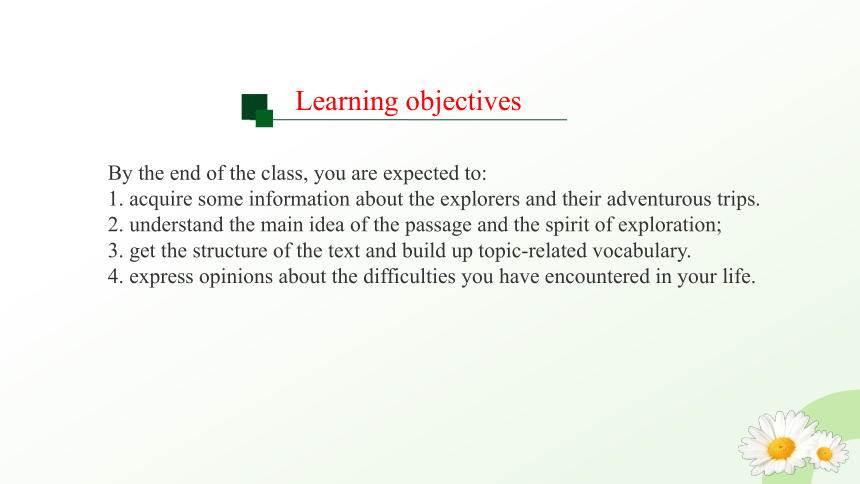
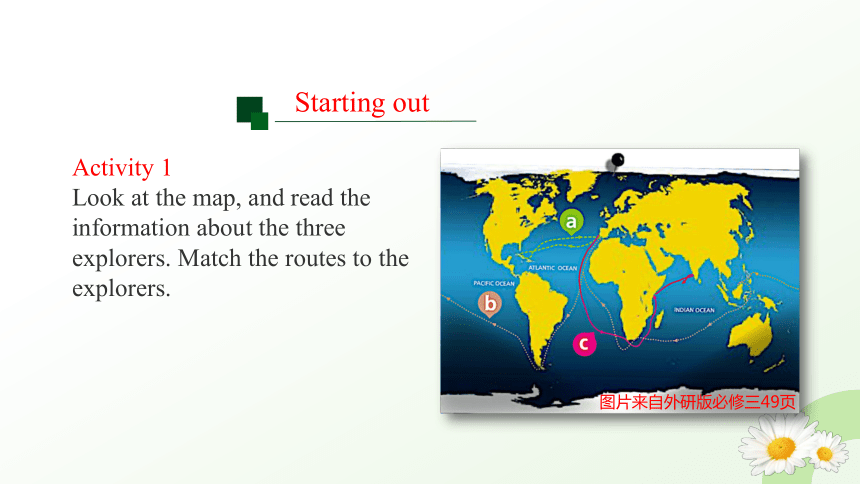
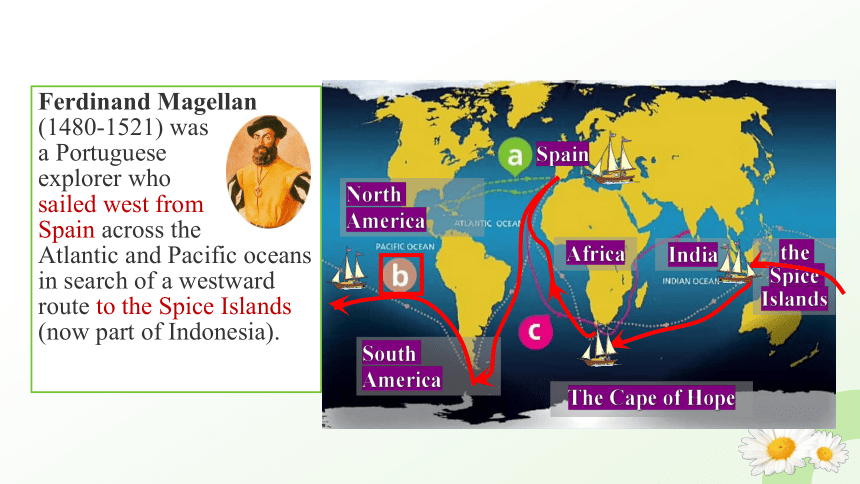
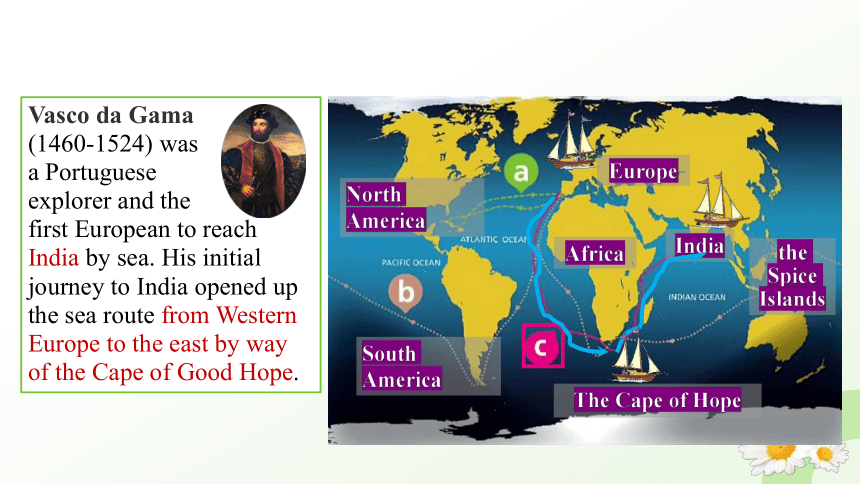
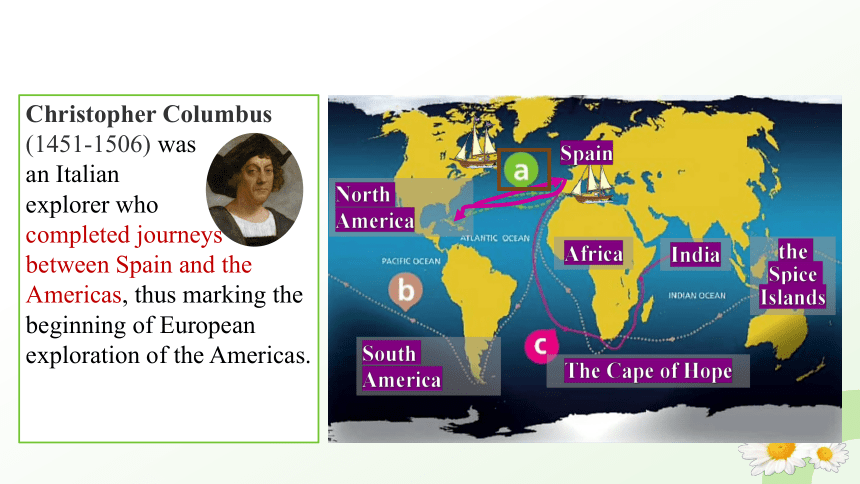

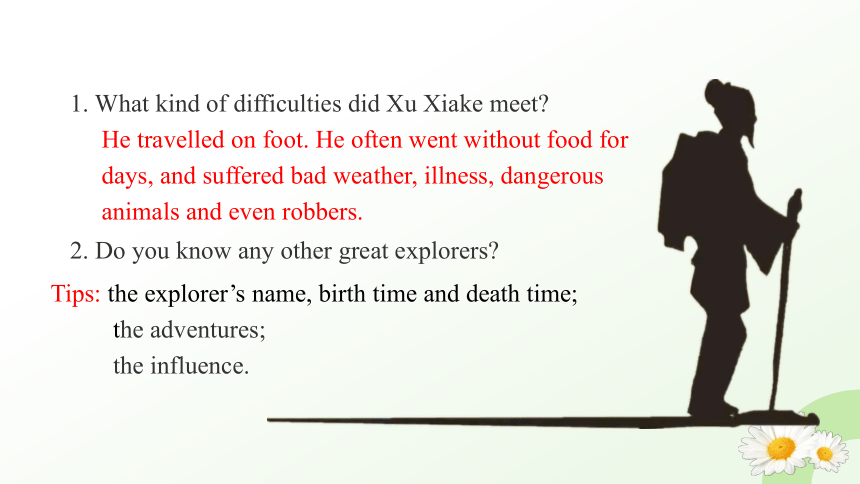
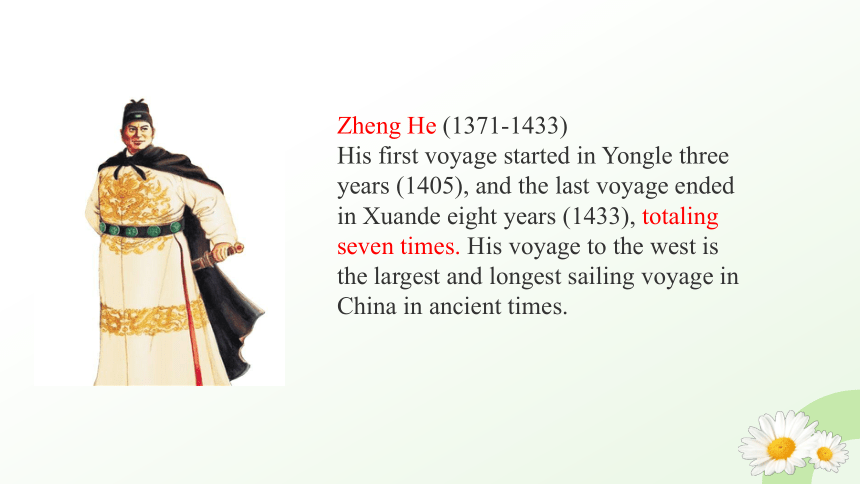
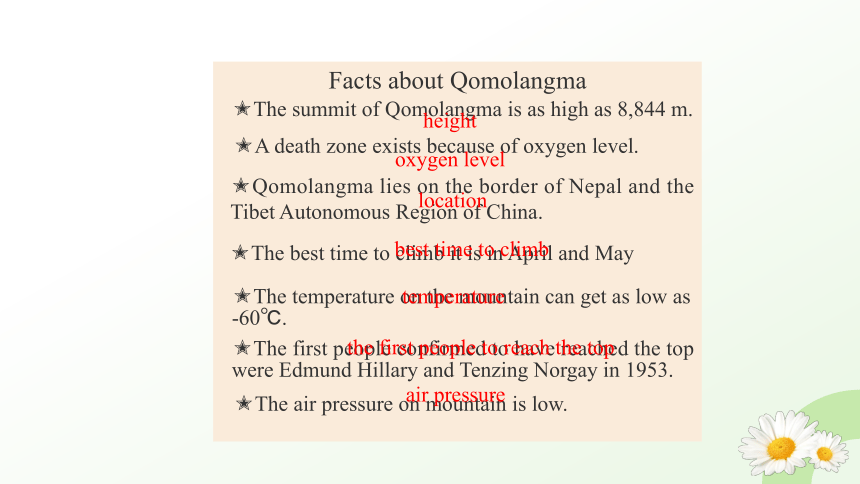
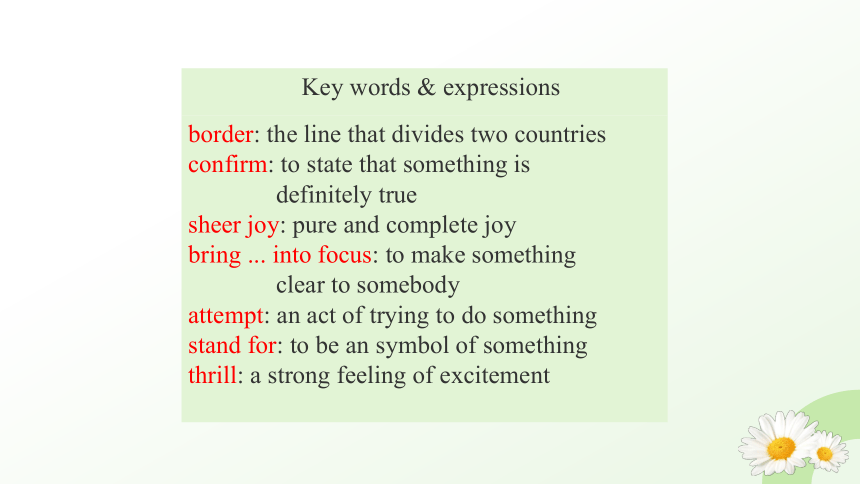
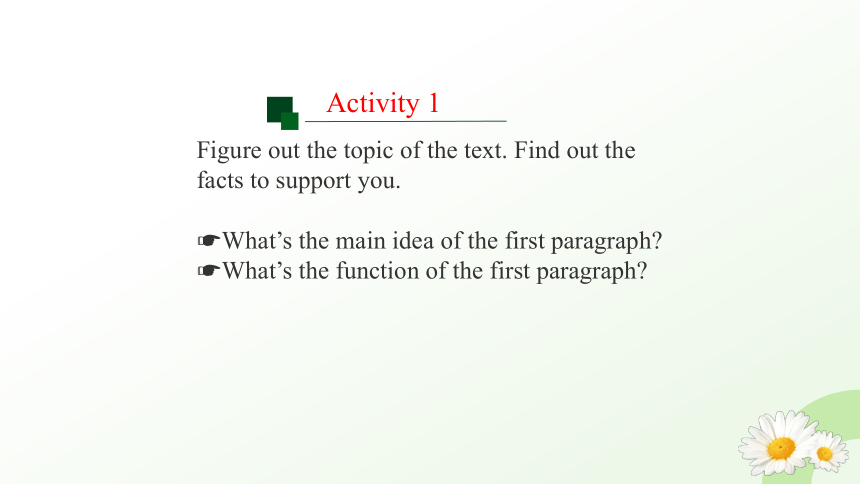
文档简介
(共33张PPT)
Unit 5 What an adventure!
Starting out & Understanding ideas
单击此处添加副标题
Learning objectives
By the end of the class, you are expected to:
1. acquire some information about the explorers and their adventurous trips.
2. understand the main idea of the passage and the spirit of exploration;
3. get the structure of the text and build up topic-related vocabulary.
4. express opinions about the difficulties you have encountered in your life.
Starting out
Activity 1
Look at the map, and read the information about the three explorers. Match the routes to the explorers.
图片来自外研版必修三49页
Ferdinand Magellan (1480-1521) was
a Portuguese
explorer who
sailed west from
Spain across the
Atlantic and Pacific oceans in search of a westward route to the Spice Islands (now part of Indonesia).
Africa
the Spice Islands
North America
India
South America
The Cape of Hope
Spain
Vasco da Gama
(1460-1524) was
a Portuguese
explorer and the
first European to reach India by sea. His initial journey to India opened up the sea route from Western Europe to the east by way of the Cape of Good Hope.
Africa
the Spice Islands
North America
India
South America
The Cape of Hope
Europe
Christopher Columbus
(1451-1506) was
an Italian
explorer who
completed journeys between Spain and the Americas, thus marking the beginning of European exploration of the Americas.
Africa
the Spice Islands
North America
India
South America
The Cape of Hope
Spain
Watch the video and answer the questions.
What kind of difficulties did Xu Xiake meet
Do you know any other great explorers
Activity 2
2. Do you know any other great explorers
1. What kind of difficulties did Xu Xiake meet
He travelled on foot. He often went without food for days, and suffered bad weather, illness, dangerous animals and even robbers.
Tips: the explorer’s name, birth time and death time;
the adventures;
the influence.
Zheng He (1371-1433)
His first voyage started in Yongle three years (1405), and the last voyage ended in Xuande eight years (1433), totaling seven times. His voyage to the west is the largest and longest sailing voyage in China in ancient times.
Facts about Qomolangma
The summit of Qomolangma is as high as 8,844 m.
A death zone exists because of oxygen level.
Qomolangma lies on the border of Nepal and the Tibet Autonomous Region of China.
The best time to climb it is in April and May
The temperature on the mountain can get as low as -60℃.
The first people confirmed to have reached the top were Edmund Hillary and Tenzing Norgay in 1953.
The air pressure on mountain is low.
height
oxygen level
location
best time to climb
temperature
the first people to reach the top
air pressure
Key words & expressions
border: the line that divides two countries
confirm: to state that something is
definitely true
sheer joy: pure and complete joy
bring ... into focus: to make something
clear to somebody
attempt: an act of trying to do something
stand for: to be an symbol of something
thrill: a strong feeling of excitement
Activity 1
Figure out the topic of the text. Find out the facts to support you.
What’s the main idea of the first paragraph
What’s the function of the first paragraph
1 Last year, hundreds of people spent good money on an experience that they knew would include crowds,
discomfort and danger. Many would
become sick, due to the extreme cold
and low air pressure, a few would
even lose their lives. Yet, despite all this, by the end of the trip many were already planning to return. For these
people, chmbing Qomolangma is an
experience like no other, making some feel weak and others, powerful.
What’s the main idea of the first paragraph
Although there are many risks in climbing Qomolangma, it is still a special experience.
What’s the function of the first paragraph
To introduce the topic.
2 British mountain climber George Mallory wrote of climbing Qomolangma, "What we get from this adventure is just sheer joy... We do not live to eat and make money. We eat and make money to be able to enjoy life. That is what life means and what life is for."Sady, Mallory would die on the mountain in 1924, although his body would not be found until many years later. It is still not known if he succeeded in reaching the top of Qomolangma before it took his life.
What’s the main idea of para. 2-3
3 In 2011, words similar to those of Mallory were spoken by American mountain climber Alan Arnette, who climbed Qomolangma in that year and was going to climb other high mountains around the world. “It brings into focus what’s important to you.” He added, “There are a thousand reasons to turn around and only one to keep going. You really have to focus on the one reason that’s most important and unique to you. It forces you to look deep inside yourself and figure out if you really have the physical, as well as mental, toughness to push when you want to stop.”
What’s the main idea of para. 2-3
Subjective reasons why people climb Qomolangma.
4 With the majority of attempts to climb Qomolangma resulting either in total success or failure, is there also a scientific reason behind this risk-taking Recent studies indicate that risk-taking may be part of human nature, with some of us more likely to take risks than others. Psychologist Frank Farley has spent years studying people who jump out of planes and drive fast cars, as well as those who climb Qomolangma. He refers to the
What’s the main idea of para. 4-6
personalities of these people as “Type T”, with the “T” standing for “thrill”.
5 Speaking to the LA Times about the “Type T” personalities, Farley said, “They’ll say, I’m not taking risks, I'm an expert...'They don't want to die and they don’t expect to die.”
6 Research also suggests that our desire to seek risks can be connected to how much we expect to benefit from the result.
What’s the main idea of para 4-para 6
Scientific reasons why people climb Qomolangma.
What’s the function of para 2-para 6
To explain why climbing Qomolangma is a special
experience in detail .
/To support the topic with details.
What’s the main idea of the last paragraph
It’s up to readers to decide whether the benefits of climbing Qomolangma are worth the risks.
What’s the function of the last paragraph
To draw a conclusion.
7 With this in mind, are the benefits of climbing Qomolangma worth the risks It's totally up to you.
Para 1 Although there are many risks in climbing Qomolangma, it is still a special experience.
Para 2- Para 3 Subjective reasons.
Para 4-Para 6 Scientific reasons.
Para 7 It’s up to readers to decide whether the benefits of climbing Qomolangma are worth the risks.
Part 1(Para. 1) Introduction
Part 2 (Para. 2-6) Body
(Supporting Details)
Part 3 (Para. 7) Conclusion
The structure of the text
Argumentation: The author expresses his/her point of view in a text, using logical reasons to support his/her opinion.
Finish Task 3 and Task 4 on page 52.
Activity 2
Choose the author’s purpose in writing the passage.
1. To encourage people to climb Qomolangma if fully prepared, as risks bring many benefits.
2. To remind people to balance the benefits and risks before deciding to climb Qomolangma.
3. To suggest that people stop taking risks and climbing Qomolangma, as the risks outweigh the benefits.
Why do people climb Qomolangma
George Mallory What people get from this adventure is just 1
People eat and make money to be able to 2 not the other way round.
Alan Arnette Each person has a(n) 3 reason for climbing a mountain. It forces people to 4 themselves. To succeed, people must have the physical as well as
5
sheer joy.
enjoy life,
important and unique
look deep inside
mental toughness .
pure and complete joy
Scientific reasons Risk-taking may be part of
6 People who are more likely to 7 have “Type T” personalities. Research also suggests that our desire to seek risks can be connected to how much we expect to 8
human nature.
take risks
benefit from
the result.
What kind of spirits do adventurers need
After reading the passage what would you do when
climbing “Qomolangma” in your life
Activity 3
How to be logical and organized Introduction personally; I want to present what I think on...; in my opinion; from my point of view; as far as I am concerned Useful expressions
crowds; discomfort anddangers, become sick, lose one’s life; enjoy life;
an experience like no other; sheer joy; look deep inside;
bring... into focus;
scientific reasons,;
human nature; one’s desire to seek risks;
benefit from the result
Body (reasons; examples; measures...) to begin with; what’s more; besides; first and foremost; furthermore; in addition; more importantly; last but not least for example; take.. as an example; as for; in this case; as you know; in particular; put it simply Conclusion in a word; therefore; in brief; to sum up; As is mentioned above, ... 1. What kind of spirits do adventurers need
brave
cautious
strong-minded
strong-willed
adventurous spirits
optimistic
persistent
positive
fearless
courageous
2. After reading the passage what would you do when climbing “Qomolangma” in your life
When faced with difficulties and even dangers, climbers and explorers never give up. They are willing to take the risks and the challenges with great courage. That’s the spirit of exploration.
The sky is the limit.
learning pressure
self-discipline
disease
Gaokao
Review
1. Acquire some information about explorers and
their adventurous trips.
2. Understand the main idea of the passage and the
spirit of exploration;
3. Get the structure of the text and build up topic-
related vocabulary.
4. Express opinions about the difficulties you have
encountered in your real life.
1. Draw a mind map about the passage.
2. Make a self-assessment about your essay.
3. Fill in the blanks with an appropriate
word or the right form of the words given.
Homework
Unit 5 What an adventure!
Starting out & Understanding ideas
单击此处添加副标题
Learning objectives
By the end of the class, you are expected to:
1. acquire some information about the explorers and their adventurous trips.
2. understand the main idea of the passage and the spirit of exploration;
3. get the structure of the text and build up topic-related vocabulary.
4. express opinions about the difficulties you have encountered in your life.
Starting out
Activity 1
Look at the map, and read the information about the three explorers. Match the routes to the explorers.
图片来自外研版必修三49页
Ferdinand Magellan (1480-1521) was
a Portuguese
explorer who
sailed west from
Spain across the
Atlantic and Pacific oceans in search of a westward route to the Spice Islands (now part of Indonesia).
Africa
the Spice Islands
North America
India
South America
The Cape of Hope
Spain
Vasco da Gama
(1460-1524) was
a Portuguese
explorer and the
first European to reach India by sea. His initial journey to India opened up the sea route from Western Europe to the east by way of the Cape of Good Hope.
Africa
the Spice Islands
North America
India
South America
The Cape of Hope
Europe
Christopher Columbus
(1451-1506) was
an Italian
explorer who
completed journeys between Spain and the Americas, thus marking the beginning of European exploration of the Americas.
Africa
the Spice Islands
North America
India
South America
The Cape of Hope
Spain
Watch the video and answer the questions.
What kind of difficulties did Xu Xiake meet
Do you know any other great explorers
Activity 2
2. Do you know any other great explorers
1. What kind of difficulties did Xu Xiake meet
He travelled on foot. He often went without food for days, and suffered bad weather, illness, dangerous animals and even robbers.
Tips: the explorer’s name, birth time and death time;
the adventures;
the influence.
Zheng He (1371-1433)
His first voyage started in Yongle three years (1405), and the last voyage ended in Xuande eight years (1433), totaling seven times. His voyage to the west is the largest and longest sailing voyage in China in ancient times.
Facts about Qomolangma
The summit of Qomolangma is as high as 8,844 m.
A death zone exists because of oxygen level.
Qomolangma lies on the border of Nepal and the Tibet Autonomous Region of China.
The best time to climb it is in April and May
The temperature on the mountain can get as low as -60℃.
The first people confirmed to have reached the top were Edmund Hillary and Tenzing Norgay in 1953.
The air pressure on mountain is low.
height
oxygen level
location
best time to climb
temperature
the first people to reach the top
air pressure
Key words & expressions
border: the line that divides two countries
confirm: to state that something is
definitely true
sheer joy: pure and complete joy
bring ... into focus: to make something
clear to somebody
attempt: an act of trying to do something
stand for: to be an symbol of something
thrill: a strong feeling of excitement
Activity 1
Figure out the topic of the text. Find out the facts to support you.
What’s the main idea of the first paragraph
What’s the function of the first paragraph
1 Last year, hundreds of people spent good money on an experience that they knew would include crowds,
discomfort and danger. Many would
become sick, due to the extreme cold
and low air pressure, a few would
even lose their lives. Yet, despite all this, by the end of the trip many were already planning to return. For these
people, chmbing Qomolangma is an
experience like no other, making some feel weak and others, powerful.
What’s the main idea of the first paragraph
Although there are many risks in climbing Qomolangma, it is still a special experience.
What’s the function of the first paragraph
To introduce the topic.
2 British mountain climber George Mallory wrote of climbing Qomolangma, "What we get from this adventure is just sheer joy... We do not live to eat and make money. We eat and make money to be able to enjoy life. That is what life means and what life is for."Sady, Mallory would die on the mountain in 1924, although his body would not be found until many years later. It is still not known if he succeeded in reaching the top of Qomolangma before it took his life.
What’s the main idea of para. 2-3
3 In 2011, words similar to those of Mallory were spoken by American mountain climber Alan Arnette, who climbed Qomolangma in that year and was going to climb other high mountains around the world. “It brings into focus what’s important to you.” He added, “There are a thousand reasons to turn around and only one to keep going. You really have to focus on the one reason that’s most important and unique to you. It forces you to look deep inside yourself and figure out if you really have the physical, as well as mental, toughness to push when you want to stop.”
What’s the main idea of para. 2-3
Subjective reasons why people climb Qomolangma.
4 With the majority of attempts to climb Qomolangma resulting either in total success or failure, is there also a scientific reason behind this risk-taking Recent studies indicate that risk-taking may be part of human nature, with some of us more likely to take risks than others. Psychologist Frank Farley has spent years studying people who jump out of planes and drive fast cars, as well as those who climb Qomolangma. He refers to the
What’s the main idea of para. 4-6
personalities of these people as “Type T”, with the “T” standing for “thrill”.
5 Speaking to the LA Times about the “Type T” personalities, Farley said, “They’ll say, I’m not taking risks, I'm an expert...'They don't want to die and they don’t expect to die.”
6 Research also suggests that our desire to seek risks can be connected to how much we expect to benefit from the result.
What’s the main idea of para 4-para 6
Scientific reasons why people climb Qomolangma.
What’s the function of para 2-para 6
To explain why climbing Qomolangma is a special
experience in detail .
/To support the topic with details.
What’s the main idea of the last paragraph
It’s up to readers to decide whether the benefits of climbing Qomolangma are worth the risks.
What’s the function of the last paragraph
To draw a conclusion.
7 With this in mind, are the benefits of climbing Qomolangma worth the risks It's totally up to you.
Para 1 Although there are many risks in climbing Qomolangma, it is still a special experience.
Para 2- Para 3 Subjective reasons.
Para 4-Para 6 Scientific reasons.
Para 7 It’s up to readers to decide whether the benefits of climbing Qomolangma are worth the risks.
Part 1(Para. 1) Introduction
Part 2 (Para. 2-6) Body
(Supporting Details)
Part 3 (Para. 7) Conclusion
The structure of the text
Argumentation: The author expresses his/her point of view in a text, using logical reasons to support his/her opinion.
Finish Task 3 and Task 4 on page 52.
Activity 2
Choose the author’s purpose in writing the passage.
1. To encourage people to climb Qomolangma if fully prepared, as risks bring many benefits.
2. To remind people to balance the benefits and risks before deciding to climb Qomolangma.
3. To suggest that people stop taking risks and climbing Qomolangma, as the risks outweigh the benefits.
Why do people climb Qomolangma
George Mallory What people get from this adventure is just 1
People eat and make money to be able to 2 not the other way round.
Alan Arnette Each person has a(n) 3 reason for climbing a mountain. It forces people to 4 themselves. To succeed, people must have the physical as well as
5
sheer joy.
enjoy life,
important and unique
look deep inside
mental toughness .
pure and complete joy
Scientific reasons Risk-taking may be part of
6 People who are more likely to 7 have “Type T” personalities. Research also suggests that our desire to seek risks can be connected to how much we expect to 8
human nature.
take risks
benefit from
the result.
What kind of spirits do adventurers need
After reading the passage what would you do when
climbing “Qomolangma” in your life
Activity 3
How to be logical and organized Introduction personally; I want to present what I think on...; in my opinion; from my point of view; as far as I am concerned Useful expressions
crowds; discomfort anddangers, become sick, lose one’s life; enjoy life;
an experience like no other; sheer joy; look deep inside;
bring... into focus;
scientific reasons,;
human nature; one’s desire to seek risks;
benefit from the result
Body (reasons; examples; measures...) to begin with; what’s more; besides; first and foremost; furthermore; in addition; more importantly; last but not least for example; take.. as an example; as for; in this case; as you know; in particular; put it simply Conclusion in a word; therefore; in brief; to sum up; As is mentioned above, ... 1. What kind of spirits do adventurers need
brave
cautious
strong-minded
strong-willed
adventurous spirits
optimistic
persistent
positive
fearless
courageous
2. After reading the passage what would you do when climbing “Qomolangma” in your life
When faced with difficulties and even dangers, climbers and explorers never give up. They are willing to take the risks and the challenges with great courage. That’s the spirit of exploration.
The sky is the limit.
learning pressure
self-discipline
disease
Gaokao
Review
1. Acquire some information about explorers and
their adventurous trips.
2. Understand the main idea of the passage and the
spirit of exploration;
3. Get the structure of the text and build up topic-
related vocabulary.
4. Express opinions about the difficulties you have
encountered in your real life.
1. Draw a mind map about the passage.
2. Make a self-assessment about your essay.
3. Fill in the blanks with an appropriate
word or the right form of the words given.
Homework
